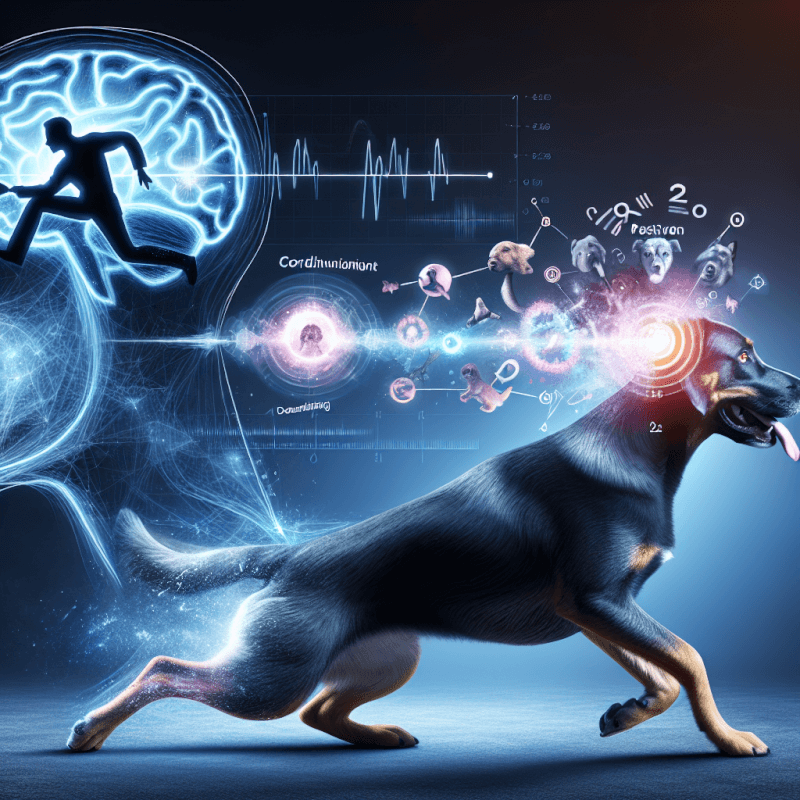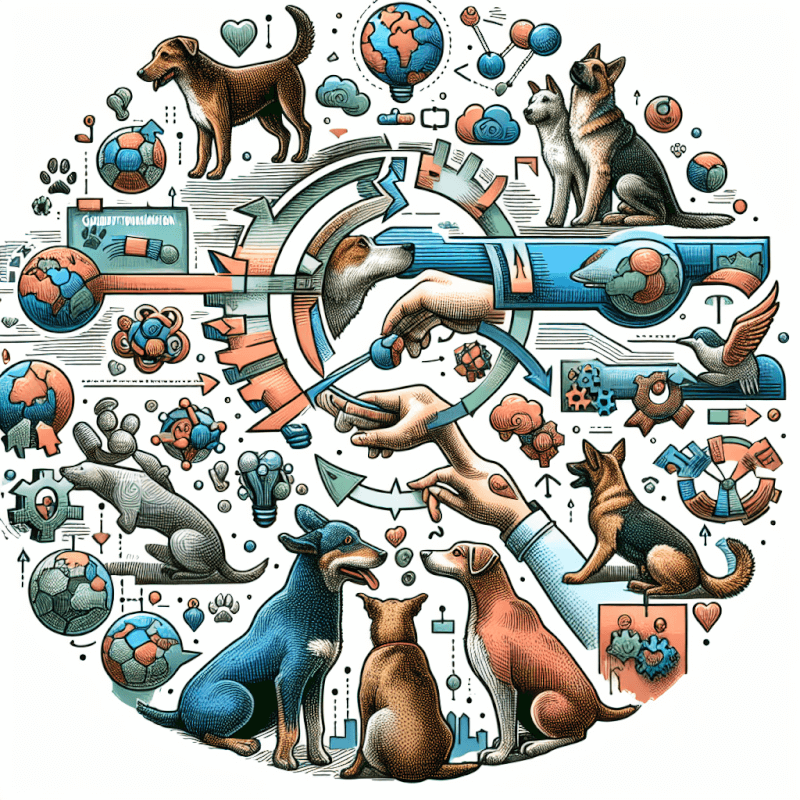Are you struggling with training your furry friend? Look no further! In this article, we will explore the world of dog training behavior analysis. Understanding your dog’s behaviors can be the key to successful training. From analyzing body language to deciphering the meaning behind certain actions, we will provide you with valuable insights and techniques to enhance your training sessions. Get ready to strengthen the bond with your four-legged companion and discover the fascinating world of dog training behavior analysis.
Understanding Dog Behavior
The Importance of Understanding Dog Behavior
Understanding dog behavior is crucial for building strong relationships between dogs and their owners. When you have a clear understanding of why dogs behave the way they do, you can better communicate and meet their needs. This understanding also helps prevent and address behavior problems, ensuring a happy and harmonious living environment for both you and your furry friend.
Ready for Cat Trivia?
Test your knowledge about cats!

Common Dog Behaviors
Dogs exhibit a variety of behaviors that are typical for their species. These behaviors include wagging their tails, barking, jumping, digging, chewing, and more. It is important to recognize and understand these common behaviors to interpret your dog’s communication effectively. For example, wagging of the tail can represent happiness or excitement, whereas a tucked tail may indicate fear or submission. By familiarizing yourself with common dog behaviors, you can better understand your dog’s state of mind.
Factors Affecting Dog Behavior
Several factors impact a dog’s behavior, including genetics, past experiences, training, and socialization. Genetics can contribute to a dog’s temperament and predisposition to certain behaviors. Past experiences, such as traumatic events or lack of socialization during critical periods, can shape a dog’s behavior. Training and socialization also play a significant role, as they teach dogs appropriate behaviors and help them adapt to various environments. It is essential to consider these factors when analyzing a dog’s behavior to tailor their training and address any behavior issues effectively.
Methods of Dog Training
Positive Reinforcement
Positive reinforcement is a highly effective and humane method of dog training. It involves rewarding desired behaviors with treats, praise, or other positive stimuli. By associating the behavior with a positive outcome, dogs are more likely to repeat the behavior in the future. Positive reinforcement builds trust and strengthens the bond between you and your dog. This method is particularly helpful for teaching commands, shaping new behaviors, and addressing behavior problems.
Negative Reinforcement
Negative reinforcement, although often misunderstood, can be a useful training tool when used correctly. It involves removing an unpleasant stimulus or aversive when the dog performs a desired behavior. For example, releasing pressure on a dog’s collar when they stop pulling on a leash. Negative reinforcement should always be used sparingly and in conjunction with positive reinforcement techniques. It is essential to prioritize the dog’s well-being and avoid causing unnecessary distress.
Clicker Training
Clicker training is a fantastic technique that utilizes a small device called a clicker to mark desired behaviors. The click sound serves as a precise and consistent signal that informs the dog they have done something right. The clicker is paired with positive reinforcement, typically in the form of treats or praise. Clicker training allows for prompt communication and helps dogs associate the click with receiving a reward. This method is especially effective for shaping complex behaviors and precise commands.
Marker Training
Marker training is similar to clicker training but uses a verbal marker, such as the word “yes” or a distinct sound, to indicate a correct behavior. Like clicker training, marker training pairs the marker with positive reinforcement. The verbal marker provides flexibility, as it can be used in various situations without the need for a physical clicker. Marker training is a valuable method for teaching obedience commands and shaping behaviors.

Dog Behavior Problems
Common Dog Behavior Problems
Dog behavior problems can range from mild nuisances to serious issues that require professional intervention. Some common behavior problems include excessive barking, separation anxiety, aggression, digging, chewing, and inappropriate elimination. It is vital to address these problems promptly to prevent them from worsening or negatively impacting your dog’s well-being. Understanding the causes of these behavior problems is the first step in addressing them effectively.
Causes of Dog Behavior Problems
Dog behavior problems can arise from various underlying causes. Lack of proper socialization during early development stages, insufficient exercise or mental stimulation, fear or anxiety, medical conditions, trauma, or inconsistent training can all contribute to behavior problems. Identifying the root cause of the problem is crucial for developing an effective behavior modification plan.
How to Address Behavior Problems
Addressing behavior problems requires a tailored approach based on the specific issue and its underlying cause. It is essential to consult with a professional dog trainer or behaviorist to develop a plan that suits your dog’s needs. Behavior modification techniques, such as positive reinforcement, desensitization, counterconditioning, and management strategies, may be employed to address behavior problems effectively. Consistency, patience, and understanding are key when working to resolve these issues and help your dog thrive.
Analyzing Dog Behavior
Observation and Recording
Observation and recording are fundamental tools for analyzing dog behavior. By keenly observing your dog’s actions, body language, and vocalizations, you can gather valuable insights into their emotional state and motivations. It is helpful to keep a behavior journal, noting specific behaviors, triggers, and environmental factors that might influence your dog’s behavior. This information can aid in identifying patterns and refining the training and behavior modification approaches.
Identifying Triggers and Patterns
Identifying triggers and patterns is crucial for understanding why your dog behaves in a certain way. Triggers can be specific objects, noises, people, or situations that cause your dog to react. By recognizing these triggers, you can take proactive steps to manage or modify your dog’s response. Identifying patterns helps you understand if there are specific contexts or times when your dog is more likely to exhibit certain behaviors. This information allows you to adjust your training methods to address these behaviors effectively.
Determining Reinforcement and Punishment
Determining what reinforces or punishes your dog’s behavior is essential for effective training and behavior modification. Positive reinforcement, such as treats, praise, or play, strengthens desired behaviors. Understanding what your dog finds rewarding allows you to use these incentives to encourage good behavior. Similarly, identifying what acts as punishment for your dog enables you to avoid or redirect behaviors that you wish to discourage. It is crucial to focus on positive reinforcement and avoid punitive methods that may harm the relationship and trust between you and your dog.
Assessing Contextual Factors
Contextual factors, such as the physical environment, social interactions, and previous experiences, shape and influence a dog’s behavior. Assessing these factors is crucial for understanding the broader context in which behavior occurs. For example, a dog displaying aggression towards other dogs in a park may act differently at home. By considering these contextual factors, you can tailor your training and behavior modification strategies to address specific situations more effectively.

Applying Behavior Analysis in Dog Training
Setting Clear Training Goals
Before beginning any training program, it is important to set clear and realistic training goals. Whether teaching basic commands, solving behavior problems, or participating in dog sports, having specific objectives helps you stay focused and track progress. Clear training goals also allow you to break down complex tasks into manageable steps, making the training process more efficient and rewarding for both you and your dog.
Creating a Training Plan
A training plan serves as a roadmap for achieving your training goals. It outlines the steps and techniques you will use to teach or modify behavior. A well-organized training plan includes a structured progression of exercises, clear cues or signals, reinforcement strategies, and criteria for success. Having a well-thought-out plan ensures consistency, promotes learning, and fosters success in training your dog.
Implementing Training Techniques
Implementing training techniques involves teaching your dog specific behaviors or modifying existing ones. This may include teaching obedience commands, addressing behavior problems, or refining advanced skills. Utilizing positive reinforcement techniques, such as rewarding desired behaviors, shaping behaviors through successive approximations, and using prompts and cues effectively, ensures effective and humane training.
Monitoring Progress and Adjusting Training
Monitoring your dog’s progress throughout the training process is crucial for success. Regular assessment helps you gauge your dog’s understanding, identify areas that need improvement, and adjust your training approach accordingly. Being attentive to your dog’s needs, providing appropriate feedback, and making necessary modifications to your training techniques ensures continued progress and facilitates a positive and enjoyable training experience for you and your dog.
Understanding Operant Conditioning
Basic Principles of Operant Conditioning
Operant conditioning is a fundamental concept in dog training and behavior analysis. It involves the modification of behavior through the use of consequences. In operant conditioning, behaviors are influenced by the consequences that follow them. Positive consequences increase the likelihood of a behavior occurring again, while negative consequences decrease the likelihood of a behavior repeating. Understanding the basic principles of operant conditioning helps you utilize effective training techniques and effectively shape your dog’s behavior.
Positive and Negative Reinforcement
Positive reinforcement involves providing a pleasant consequence, such as treats, praise, or play, to reinforce desired behaviors. By associating the behavior with a positive outcome, dogs are motivated to repeat the behavior. Negative reinforcement involves removing an aversive or unpleasant stimulus when the dog performs the desired behavior. For example, releasing tension on the leash when the dog stops pulling. Both positive and negative reinforcement techniques are valuable tools for training and shaping behavior.
Positive and Negative Punishment
Positive punishment involves applying an aversive consequence, such as a firm “no” or timeout, to discourage unwanted behaviors. Negative punishment involves removing a pleasant stimulus, such as attention or privileges, when the dog exhibits undesirable behavior. While punishment techniques can be effective in certain situations, their use should be limited, and positive reinforcement should be prioritized to foster a positive and trusting relationship with your dog.
Schedules of Reinforcement
Schedules of reinforcement determine when and how often reinforcement is delivered in response to a behavior. Continuous reinforcement delivers reinforcement every time the behavior occurs, which is useful for initial learning. However, using intermittent or partial reinforcement, where reinforcement is delivered sporadically, can increase the durability and resistance to extinction of the behavior. Understanding the different schedules of reinforcement helps you choose the most appropriate method for training and maintaining desired behaviors.

Using Behavior Analysis for Obedience Training
Teaching Basic Commands
Obedience training is an essential aspect of dog training, and teaching basic commands provides a foundation for good behavior and communication. Through the use of positive reinforcement techniques, such as rewarding the dog for sitting, staying, and coming when called, you can shape these fundamental obedience behaviors. Consistent training, clear cues, and gradual progression are essential when teaching basic commands.
Addressing Leash Pulling
Leash pulling is a common problem that can be addressed using behavior analysis techniques. Understanding the underlying triggers, such as excitement or a desire to explore, can help modify the behavior effectively. By using positive reinforcement techniques, such as rewarding the dog for walking calmly beside you, you can teach them appropriate leash manners. Consistency, patience, and managing the environment are key when addressing leash pulling.
Eliminating Jumping on People
Jumping on people is a behavior that many dog owners find undesirable. To eliminate this behavior, it is important to identify the reasons behind it, such as seeking attention or excitement. Teaching your dog an alternative behavior, like sitting or offering a paw, can redirect their attention and provide an opportunity for positive reinforcement. Consistency, positive reinforcement, and clear communication with guests are crucial in addressing jumping on people.
Curb Excessive Barking
Excessive barking can be a challenging behavior to address, but behavior analysis techniques can be helpful. Identifying the triggers, such as boredom, fear, or a desire to alert, allows you to develop an appropriate behavior modification plan. Providing mental and physical stimulation, like interactive toys and regular exercise, helps alleviate boredom and reduce excessive barking. Desensitization and counterconditioning techniques can also be utilized to change your dog’s emotional response to specific triggers, effectively reducing barking.
Behavior Analysis for Aggression and Fear Issues
Identifying Aggression and Fear Signs
Identifying signs of aggression and fear is crucial for addressing these issues effectively. Aggression signs may include growling, baring teeth, snapping, or lunging. Fear signs may include cowering, trembling, excessive panting, or attempting to escape. Recognizing these signs allows you to understand and respond appropriately to your dog’s emotional state. It is important to seek professional help when dealing with aggression or fear issues to ensure the safety of everyone involved.
Addressing Dog Aggression
Addressing dog aggression requires careful assessment and a well-planned behavior modification program. Understanding the triggers that elicit aggression, such as resource guarding or fear of unfamiliar dogs, is vital for creating a safe and effective training plan. Techniques such as desensitization, counterconditioning, and implementing appropriate management strategies can help address aggression while prioritizing the well-being of both dogs and people.
Dealing with Fear and Anxiety
Fear and anxiety can significantly impact a dog’s well-being and behavior. Gentle and patient behavior modification techniques can help dogs overcome their fears and build confidence. Gradual exposure to fear-inducing stimuli, positive reinforcement for calm behaviors, and the use of calming protocols, such as relaxation exercises or interactive toys, can assist in reducing fear and anxiety. Consulting with a qualified professional is recommended to ensure a caring and effective approach tailored to your dog’s specific needs.

The Role of Environmental Enrichment
Providing Mental Stimulation
Environmental enrichment plays a crucial role in promoting a dog’s overall well-being and behavior. Providing mental stimulation, such as puzzle toys, interactive games, and training sessions, keeps dogs mentally engaged and prevents boredom. Mental stimulation not only alleviates behavioral issues but also enhances cognitive abilities and prevents destructive behaviors that may arise from frustration or lack of mental engagement.
Physical Exercise and Play
Regular physical exercise and play are essential for a dog’s physical and mental health. Engaging in activities such as walks, runs, fetch, or agility training helps dogs release pent-up energy, maintain a healthy weight, and reduce the risk of behavior problems. Physical exercise also promotes better sleep and overall relaxation, contributing to a balanced and contented dog.
Creating a Safe and Comfortable Environment
Creating a safe and comfortable environment is vital for promoting positive behavior. Providing a designated resting area, comfortable bedding, and appropriate hiding spaces gives your dog a sense of security. Ensuring that your home environment is free from hazards, such as toxic substances or potentially dangerous items, minimizes stress and protects your dog’s well-being. A secure and peaceful environment fosters a calm and well-behaved dog.
Socialization with Other Dogs and People
Socialization is crucial for dogs to learn proper social skills and build confidence. Regular and positive exposure to various dogs, people, and environments helps dogs become well-adjusted and friendly. Controlled interactions with well-behaved dogs and positive reinforcement for appropriate behavior can improve social skills and reduce the likelihood of fear or aggression towards others. Proper socialization enhances the quality of life for your dog and promotes harmony in various social settings.
Seeking Professional Help for Behavior Analysis
When to Consult a Professional Trainer or Behaviorist
Knowing when to seek professional help is essential for addressing complex behavior issues. If your dog is displaying severe aggression, excessive fear, or their behavior problems are negatively impacting their well-being and quality of life, it is time to consult a professional trainer or behaviorist. These experts can analyze your dog’s behavior, develop a customized behavior modification plan, and provide guidance throughout the process.
Finding a Qualified Professional
When seeking professional help, it is crucial to find a qualified and experienced trainer or behaviorist. Look for professionals who have credentials, such as certification from reputable organizations or relevant academic degrees. Additionally, seek professionals who use positive reinforcement-based methods and have experience in behavior analysis. Reading reviews, asking for referrals, and checking their previous work can help you find a professional who aligns with your training philosophy and goals.
Working Collaboratively for Behavior Improvement
Collaboration between you, your dog, and the professional is key to behavior improvement. Open communication, trust, and consistency are essential for implementing the behavior modification plan effectively. As the primary caregiver, your involvement in the training process is crucial for your dog’s success. By working collaboratively, you can achieve significant improvements in your dog’s behavior, fostering a happy and balanced relationship.



